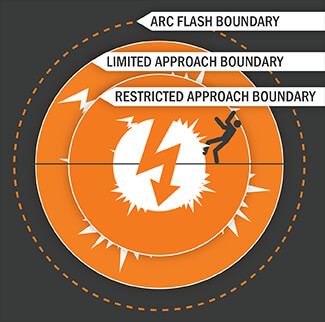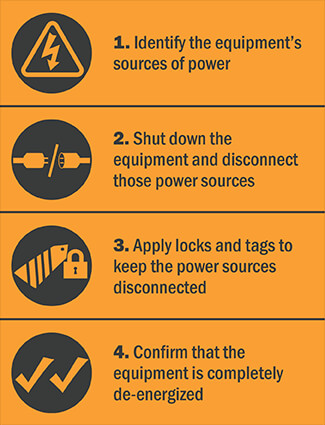Prevent Arc Flash with LO/TO and OSHA Signs
03
February,
2023
4 MINUTE READ

The Role of LO/TO and OSHA Signs in Safeguarding Against Arc Flash
In the realm of electrical safety, the risks posed by arc flash incidents loom large, presenting potentially catastrophic consequences for both workers and facilities. However, with the implementation of robust safety measures such as Lockout/Tagout (LO/TO) procedures and the strategic use of OSHA signs, organizations can significantly mitigate these risks.
The Dangers of an Arc Flash and Arc Blast
An arc flash can release a deadly blast of energy without any warning, making it one of the more frightening hazards involved with electrical work. The accompanying arc blast can cause devastating physical harm and extensive damage to equipment and surroundings, emphasizing the critical importance of proper safety measures and equipment. Arc flashes can be trigged by dropping a tool, opening a panel on degraded equipment, or even pest infestations. There is one controllable factor that unites all arc flash incidents, and that is electrical power. According to data collected from Industry Safety and Hygiene, there are thousands of arc flash related incidents each year:
- 400 deaths
- 7,000 burn injuries
- 2,000 hospitalizations
The industry standard for safe electrical work (NFPA 70E) recommends eliminating the risk of arc flash when working on electrical equipment: shut it off and lock it out.
The Electrically Safe Work Condition: Utilizing OSHA Signs

That's the main idea behind what the NFPA calls an "electrically safe work condition." NFPA 70E requires an electrically safe work condition in either of these situations:
- An employee works within the Limited Approach Boundary, a clearance area around equipment designed to prevent unqualified workers from being exposed to an electric shock hazard.
- Risk of injury from arc flash, as a result of the nature of their work or the equipment being worked on
In both of these cases, the most effective way to protect the worker is to keep the equipment in a de-energized state, with no electrical power, and to properly mark it with the appropriate OSHA signs.
De-energizing the equipment is only part of the electrically safe work condition, though. Imagine you're working on equipment that's been powered down for safety; all of the electrical hazards have been essentially eliminated. Then, another worker enters the room and flips a switch to start working on their own tasks. That could be catastrophic unless you can be certain that the equipment you're working on can't be accidentally started up again. That certainty is the idea behind lockout/tagout (LO/TO).
LO/TO Steps for Electrical Work
 Lockout/tagout procedures follow the same basic ideas:
Lockout/tagout procedures follow the same basic ideas:
- Identify the equipment's sources of power
- Shut down the equipment and disconnect those power sources
- Apply locks and tags to keep the power sources disconnected
- Confirm that the equipment is completely de-energized
With electrical work, the above steps still apply, but may require additional safety measures, including NFPA 70E training. All affected workers should be informed that equipment will be disconnected temporarily and should be told why this is the case, so there is no misunderstanding. Many electrical systems can carry power without any obvious indication that they're still energized, so the NFPA requires using appropriate testing tools to confirm the absence of power. If procedures aren't tailored for the actual electrical hazards and situations that are present in a facility, accidents and injuries are going to remain a problem.
The NFPA 70E standard includes an example of an effective LO/TO procedure in Informative Annex G. The NFPA makes recommendations to double-check each critical point in the process. The following steps are based on the NFPA's description in that informative annex.
- Notify all affected employees of equipment shut down
- Identify all sources of electrical power to the equipment
- Shut down the equipment and disconnect energy sources
- Relieve any stored energy appropriately (by grounding, attempting to start the equipment, or other means)
- Apply locks and tags that meet OSHA arc flash labeling requirements to all disconnecting devices.
- Verify that locks are properly applied.
- Use an appropriate testing tool to verify that the equipment is de-energized, and then verify that the tool is functioning correctly by testing a known voltage source.
- Where necessary, install a grounding device to eliminate the risk of induced or stored voltage.
After this process is complete, workers are free to continue working in this electrically safe work condition.
Rules for LO/TO and Arc Flash Safety Including Proper OSHA Signs
While the NFPA standard represents expert advice and industry consensus, it's not strictly required by law. Instead, workplace safety in the United States falls under the jurisdiction of OSHA and its regulations. OSHA's general requirements for safe electrical work practices are in 29 CFR 1910.333, and a basic approach for working on de-energized equipment, including a LO/TO system, appears in paragraph (b) of those rules. These rules generally align with OSHA's more extensive LO/TO rules in 29 CFR 1910.147, which go into more detail about the lockout or tagout devices that should be used.
Additionally, there are certain warning labels and signs that must adhere to the OSHA electrical panel labeling requirements to communicate hazards effectively in the workplace. Facilities that prioritize safety often rely on OSHA signs as visual cues to alert workers of potential dangers and guide them in adhering to safety protocols. Integrating OSHA signs into safety procedures ensures compliance with OSHA regulations and fosters a culture of safety awareness among employees.
It's common for facilities that prioritize safety to look to experts like the NFPA for advice on protecting their workers because these regulations can only be changed or updated through a long and involved process at the federal agency. Where a given question is not covered by regulations, OSHA frequently uses NFPA standards like NFPA 70E as an example of common industrial safety practices. Practices that do not follow common guidelines for safety may indicate disregard for safety.
A system that meets all of the NFPA's recommendations for safe practices will typically satisfy OSHA's requirements; because the NFPA updates most of its standards every three years, staying up-to-date with its recommendations will also show that a facility is paying attention to new developments in safe work practices.
OSHA Signs for Preventing Arc Flash in Your Facility
Where electrical hazards exist in your facility, it's important to train the affected workers to understand those hazards and follow safe practices. Employees who aren't performing work on a given piece of powerful equipment should know about the equipment's "danger zones" and how far back to stay by viewing the appropriate OSHA signs and labels. Finally, when work must be performed on energized equipment, your qualified workers need to have the resources to stay safe. That includes detailed equipment labels that meet all OSHA label requirements to keep them informed of details such as what personal protective equipment (PPE) they need to wear. These signs and labels can easily be made with the DuraLabel Kodiak Max Industrial Sign and Label Print System.
Get help crafting a system that will provide the safety communication you need. Call 1-888-326-9244 and one of our experts will guide you through the process.
Learn more about how to build a LO/TO system for your workplace, and how to apply it safely, download a free Arc Flash Instant Action Guide or a more detailed comprehensive guide below.
Read Next:
RELATED RESOURCES

4 Electrical Hazards of the Power Industry: OSHA Signs for Safety
OSHA Signs to Increase Safety in the Electric Power Industry In the high-risk environment of the electric ...
Read
Strengthening Arc Flash Hazard Analysis with OSHA Signs
Conducting an arc flash hazard study is the cornerstone for worker safety when working with live equipment ...
Read
Creating Compliant OSHA Signs: Tips and Best Practices
Creating compliant OSHA safety signs is a crucial element in the overarching mission of fostering a safe and ...
Read.png)



